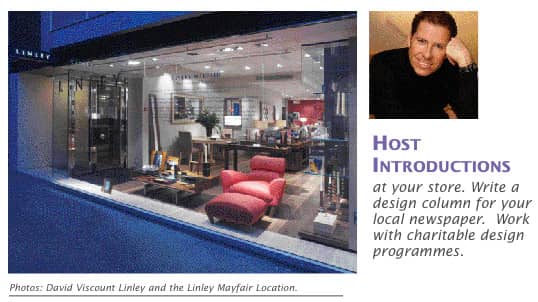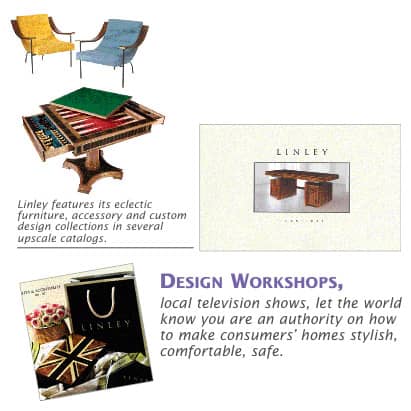“Our aim, quite simply, is to achieve excellence.”
A remarkably sunny day in Belgravia, and the shop’s double doors were open wide. There was a certain amount of good-natured jostling on the steps, casually well dressed Londoners --- and others --- coming and going with the excitement of latter day treasure seekers. Linley’s sales only happen twice a year, and the young Viscount’s prices can be such that even the very rich have been known to blink, smile, then eagerly produce cheque books. They know they’ll get what they’re paying for.
Whatever the cost, superb, stunning woods (environmentally correct!), luscious fabrics and occasional hints of whimsy, make price an irrelevant factor. Well, almost. And there’s always the thrill of rubbing elbows, figuratively and/or literally, with the hereditary elite. It’s an ambience that draws worshippers from all corners of the affluent world.
The conception and birth of any business enterprise holds endless fascination for entrepreneurs like us. It takes an interesting mix of genes and what the British sometimes call bloody-mindedness to kick-start a winning vision. David, Viscount Linley, son of Princess Margaret, the Queen’s younger sister, and Anthony Armstrong-Jones, 1st Earl of Snowden, was born in 1961 at Clarence House, London, at that time the home of Queen Elizabeth, the Queen Mother.
David was educated at Bedales School, renowned for its emphasis on arts and crafts, a perfect fit. It was a natural step to Parnham House, The School for Craftsmen in Wood. At Parnham, he was placed under the direction of the justly respected John Makepeace.
In 1982, he opened his first workshop at Dorking, Surrey, a lovely historic little town, just a 45-minute train ride from London. Here he designed and made custom furniture. Three years later, he set up David Linley Furniture Ltd., now known simply as Linley.
The flagship shop on Pimlico Road in Belgravia bustles with staff as well as customers. Multi-levelled, with two banks of open stairs, its great fenestration makes it light, bright and welcoming. Chairs, sofas, tables, desks, eye-catching floor and table lamps, and a truly intriguing, on-going selection of imaginative accessories enhance shelves, corners and table tops. There are reasons to stop and admire and chat at every turn, with helpful but unobtrusive staffers present when you need them. One basks in colour.
“There are eleven collections, some with 19th century features and some Art Deco of the ‘30s. We have seven designers, full-time, at this location and nearly everything is designed here.” Christina Macmillan, the company’s Marketing Director, is an attractive, knowledgeable, sincere devotee, typical of Linley’s corporate family. The “excellence” sought in Linley’s vision, is apparent in the seemingly effortless connection between staff and customers, an enviable seamless efficiency and good humour. Christina’s role is key, the first line of communication between the highly creative dreamers/producers and the sellers and buyers of the unique lines, whether manufactured or sourced.
Belgravia’s demographic is “mid-thirties up to any age. It’s unusual to see people in their twenties except that they might come in for gifts, the smaller items, Italian crystal and French knives and so forth. Pimlico is not on the beaten track for everyone.
“We opened the second shop in Mayfair on Albemarle Street in September, 2005. It, too, is a very busy shop but with a different sort of client, perhaps more male oriented. A business destination. And, of course, there is always talk of further expansion!”

The website is a marvellous place to show and to sell accessories. “It started off in 1997, 10 years ago, the right time to create a website, and it looked very different then. Five years ago, it was redesigned. And it’s time now for more revamping and, again, it will be entirely different.” Colourful, helpful, the website provides a superb window on Linley’s highly interactive world. Check www.davidlinley.com. You’ll find a multitude of fascinating options.
The audience has proved to be worldwide, as are design projects that evolve. The two shops are literally the tip of the Linley iceberg. “There are ongoing relationships in Moscow, Ottawa and Istanbul and many clients in the United States and Canada, Germany, Australia and right now there is a house in the Bahamas. An apartment just outside Miami was featured in Elite Traveller magazine recently.”
One of the most interesting aspects of their marketing thrust is the concentration on very visible and profitable partnerships. One of these involved “a limited edition series of bespoke* wooden trays for Krug, branded LINLEY for Krug, to be used for serving their unique prestige cuvee champagne. Their circular shape was inspired by the traditional oak fermentation casks used by Krug for the first fermentation.”
A major project is the association formed between Linley and Claridge’s, the famous London hotel. Its elegant seven stories were built in the 19th century and many of the original features from this period have been preserved. The second significant restyling took place in the 1920s in the Art Deco period. It was then that Claridge’s added its ballroom and a new wing above it, and refurbished its restaurant, entrance and several rooms and suites, all in a style called “Regency Vogue”. More restoration was done to the ground floor in 1998 by Thierry Despont, and Dale Chihuly whose airy sculpture is placed at the heart of the hotel.
Now, with Linley, a further era of design is taking shape to aesthetically fuse the 19th, 20th and 21st centuries.

Linley is entirely sympathetic to the spirit and ambience of Claridge’s title of “Art Deco jewel of Mayfair”. Original Deco features, such as glass or silver fireplaces, clocks and wall lights have in many cases become focal points. The team has completed 11 suites with more to go, some Art Deco, some Traditional and some “Hybrid”, using original pieces from both periods. Many pieces have been designed and created, and many more have been sourced. Please refer to the website for all the wonderful details, too many to review here, but too good to miss!
Of course, Christina is working hand in hand with Claridge’s promotional people and the public relations value is immeasurable. “It’s good for both sides, cross-pollination! Public relations is vital. We were part of the Grosvenor House Antique Show recently, good exposure.
“We do get a lot of press coverage. David is a high profile person, and the furniture is unique, a beautifully made product. Linley takes a much more holistic approach to home furnishings with great interest in the way people live.”
The preferred customer list is a very useful tool. “We just sent a sale card to 7,000 people in the United Kingdom. And we have a data base of 12,000 organized to reflect what people have bought and where these people live. Great place to promote Christmas and other gifts, for instance. We always do a lot of promotion around the end of the year.
“Linley does very little actual advertising. There was a bit in The Evening Standard about our sale. And a small burst at the opening of the new Mayfair shop.
“Word of mouth is so very important to us. Yes, London is a big city, but it’s also a small city in many ways, people who see one another a great deal, who interact at business, parties and other social occasions. Of course, superb customer service is indispensable, our follow-up is prompt, concerned and totally effective. And we must maintain this always.”
Visibility is the name of the game. David has written three books and lectured around the world. Venues include the Victoria and Albert Museum in London; The Metropolitan Museum of Art, New York; the Smithsonian Institute, Washington; the Museum of Fine Arts, Boston; the Art Institute, Chicago; the LA County Museum of Art; the Cooper Hewitt Museum, New York and the Dallas Museum of Art. Watch for any upcoming lectures. And there have been plenty of television opportunities wherever he has appeared, both business and design shows.
If you can get hold of Linley’s big book, “Design and Detail in the Home”, you could use it to inspire your design staff and maybe yourself. Publisher Little, Brown and Company, U.K., 2000. It’s easy reading, the design rationale is logical, and the photographs are superb. Really, “the stuff that dreams are made on”.
Brochures play their role, too, in Linley promotion. A sampling, Gifts & Accessories, 06-07, “We hope you will be delighted, impressed and amused,” says Linley, and the contents are designed to titillate. Frames; Dining; Vases; Candlesticks: For Him; For Her; Study & Library; and Artful Gifts. The latter includes a rocking horse with a secret compartment; the key is concealed in the stirrup! And there’s a Tricks Box in marquetry to play with.

“Upholstery” shows shapes, fabrics, leathers, woods and pricing. “Furniture” not only defines styling and the variety of woods used in the manufacture of the various collections, but also talks at length about “Aftercare”, cleaning methods, things to avoid. Said Christina, “We work with independent suppliers and we insist that all their timbers come from sustainable sources and that they are FSC or PEFC approved.” There’s a section on lighting, this time featuring The Tools collection, sleek, modern lamps inspired by original cabinet-making tools.
Then there’s Interior Design & Bespoke Furniture. This explains the process of engaging Linley to “create interior design schemes”. They combine “bespoke” or custom furniture, pieces taken from the retail collections and products from external suppliers. (*Bespoke: To be spoken for: made to your specifications and tailored to your needs.)
A York University marketing professor of my acquaintance said, “Linley’s done all the right things. He’s taken his own great love for design and made it into something others can enjoy. And he’s marketed his vision in a manner all can emulate in their own way, according to their demographic. Take what you know, then show how that knowledge impacts the consumer, graphically, attractively. His books and speaking tours. We can all do that in our communities and beyond. Design workshops, local television shows, let the world know you are an authority on how to make consumers’ homes stylish, comfortable, safe. Use every opportunity to host introductions at your store. Write a design column for your local newspaper. Work with charitable design programmes. Partner with other enterprises that will bring additional visibility to your product lines and services. Build a network of satisfied customers and keep them that way. And let it be known that what you are doing is fun. You are helping people create their own havens.”
If you are heading for London any time soon, go see Linley’s shops for yourself. Maybe book one of the suites at Claridge’s! In the meantime, look at that wonderful website. You’ll find you can order some of those brochures. And just let your imagination run rampant!